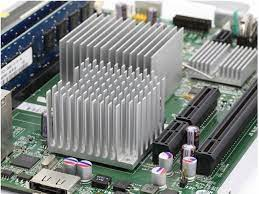In every system, the CPU, the Central Processing Unit, is often overheated because of the components inside it. These particular components overheat, and hence these effects the overall functionality of the system.
Now, we will learn how the heat sinks work and helps the CPU from overheating, thus helping increase the productivity and efficiency of the system and its components.
A heat sink is a piece of metal that usually sits on top of a computer chip, such as a CPU, and draws power away from components by letting it rise through a series of fins.
Heat sinks are passive, which means that they have no moving parts. In most cases, however, the heatsink is combined with a fan that blows the hot air away or a liquid cooling solution that carries the heat halfway through the pipes.
What is the purpose of a Heat sink?
The following thing that comes to mind is the actual purpose of using the heat sink. A CPU is usually prone to overheating because some of its components heat regularly due to overworking. If we do not use the heatsink, the heat generated by these particular components remains in your CPU, which will burn or fry the part.
Because most components are made of electronic chips inside the system, they absorb heat quickly. If they receive much heat and are not taken care of, they will be damaged, posing a risk to the functionality of high-performance computers.
Having a heat sink fixed is essential because it helps keep our CPU cool even if we use it for an extended period. It is designed to absorb the heat from our CPU and then disperse the heat away from its components, preventing the elements from getting damaged. Heat dissipation is possible because a heat sink has fins, which give more surface area during the heat transfer.
A heat sink needs to interact intensely with the heat source to maximise cooling. Heat sinks typically use a thermal conductor to move the heat into the fins, which have a larger surface area and thus disperse the heat throughout the computer.
How does the heat sink work?
A heat sink works by moving heat away from a critical component. It can explain this in four basic steps:
- The source usually generates heat: This source may be any component in the system that generates heat and requires heat removal to function smoothly without any problems such as mechanical, electrical, chemical, or friction problems.
- Heat is transferred away from the source: In direct heat sink-contact applications, heat moves into the heat sink and away from the source via natural conduction. The heat sink material’s thermal conductivity directly impacts this process. That is why high thermal conductivity materials such as copper and aluminium are widespread in making heat sinks.
- Heat distributes throughout the heat sinks: Heat will naturally travel through the heat sink via natural conduction, moving across the thermal gradient from a high-temperature to a low-temperature environment. This ultimately means that the heat sink’s thermal profile will not be consistent. As a result, heat sinks will often be hotter towards the source and cooler towards the sink’s extremities.
- Heat moves away from the heat sink: This process relies on the heat sink’s temperature gradient and its working fluid–most commonly air or a non-electrically conductive liquid.
- The working fluid passes across the surface of the warm heat sink and utilises thermal diffusion and convection to remove heat away from the surface and into the surrounding environment.
- This stage relies on, yet again, a temperature gradient to remove heat from the heat sink. Therefore, no convection and subsequent heat removal will occur if the surrounding temperature is not more excellent than the heat sink.
- This stage is also where the total surface area of the heat sink becomes most advantageous. A large surface area provides an increased area for thermal diffusion and convection to occur.

Heat sink
Types of Heat Sinks: There are three types of heat sinks,
- Passive heat sinks: Passive heat sinks usually rely on natural convection, which means that the buoyancy of hot air alone causes the airflow generated across the heat sink system. The benefit of these heat sinks is that they do not require secondary power or control systems to remove heat from the system. However, passive heat sinks are less effective at transferring heat from a system than active heat sinks.

Passive heat sink
- Active heat sinks: Active heat sinks utilise forced air to increase fluid flow across the hot area. Forced perspective is most commonly generated by a fan, blower, or even by the movement of the entire object.
An example of a fan producing forced air across a heat sink is the fan in your personal computer turning on after your computer gets warm. The fan forces air across the heat sink, which allows more unheated air to move across the heat sink surface, thus increasing the total thermal gradient across the heat sink system and allowing more heat to exit the overall design.
Active heat sink
- Hybrid heat sinks: Hybrid heat sinks are usually combined with some aspects of passive and active heat sinks. These configurations are less common and often rely on control systems to cool the system based on the temperature requirements.
When the system operates at more astonishing levels, the forced air source is not so active and only cools the system passively. Once the head reaches higher temperatures, the dynamic cooling mechanism increases the system’s cooling capacity.
Hybrid heat sink
Hence, this is an overall preview of what a heat sink is and how you could use it to maintain the system’s components from overheating, thus improving the system’s efficiency and productivity.

